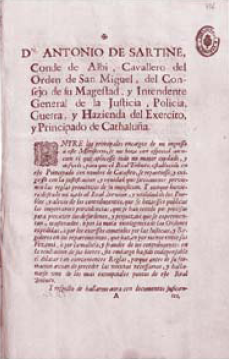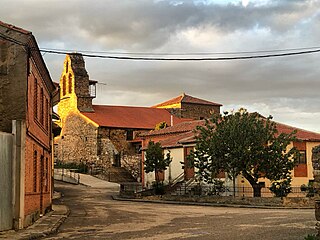
The autonomous communities are the first-level administrative divisions of Spain, created in accordance with the Spanish Constitution of 1978, with the aim of guaranteeing limited autonomy to the nationalities and regions that make up Spain.

A province in Spain is a territorial division defined as a collection of municipalities. The current provinces of Spain correspond by and large to the provinces created under the purview of the 1833 territorial re-organization of Spain, with a similar predecessor from 1822 and an earlier precedent in the 1810 Napoleonic division of Spain into 84 prefectures. There are many other groupings of municipalities that comprise the local government of Spain.
An intendant was, and sometimes still is, a public official, especially in France, Spain, Portugal, and Latin America. The intendancy system was a centralizing administrative system developed in France. In the War of the Spanish Succession of 1701 to 1714 the French royal House of Bourbon secured its hold on the throne of Spain; it extended a French-style intendancy system to Spain and Portugal - and subsequently worldwide through the Spanish Empire and Portuguese Empire. Regions were divided into districts, each administered by an intendant. The title continues in use in Spain and in parts of Spanish America for particular government officials.
A Real Audience, or simply an Audience, was an appellate court in Spain and its empire. The name of the institution literally translates as Royal Audience. The additional designation chancillería was applied to the appellate courts in early modern Spain. Each audiencia had oidores.

Zenón de Somodevilla y Bengoechea, 1st Marquess of Ensenada, commonly known as the Marquess of Ensenada, was a Spanish statesman. He played a key role in crafting and enforcing the Great Gypsy Round-up, officially known as the General Imprisonment of the Gypsies, which was an attempt to exterminate the Roma living in Spain, leading to the death of 12,000 Romani People.
The alcabala or alcavala was a sales tax of up to fourteen percent, the most important royal tax imposed by Spain in the early modern period. It applied in Spain and the Spanish dominions. The Duke of Alba imposed a five percent alcabala in the Netherlands, where it played an important role in the Dutch Revolt. Unlike most taxes in Spain at the time, no social classes were entirely exempt, although from 1491 clergy were exempt on trade that was "not for gain." Certain towns were also, at times, given exemptions.

Antoine Sartine (1681–1744), later known as Antonio de Sartine, was a French-born financier and Spanish administrator.

Coomonte is a municipality and a town located in the province of Zamora, Castile and León, Spain. According to the 2023 Census (INE), the municipality has a population of 175 inhabitants.
The Economic Agreement is a juridical instrument that regulates the taxation and financial relations between the General Administration of the Kingdom of Spain and the Autonomous Community of the Basque Country.

The Four Kingdoms of Andalusia was a collective name designating the four kingdoms of the Crown of Castile located in the southern Iberian Peninsula, south of the Sierra Morena. These kingdoms were annexed from other states by the Kingdoms of Castille during the Reconquista: the Kingdom of Córdoba was conquered in 1236, the Kingdom of Jaén in 1246, the Kingdom of Seville in 1248 and the Kingdom of Granada in 1492.

The Kingdom of Granada was a territorial jurisdiction of the Crown of Castile from the conclusion of the Reconquista in 1492 until Javier de Burgos' provincial division of Spain in 1833. This was a "kingdom" ("reino") in the second sense given by the Diccionario de la lengua española de la Real Academia Española: the Crown of Castile consisted of several such kingdoms. Its extent is detailed in Gelo del Cabildo's 1751 Respuestas Generales del Catastro de Ensenada (1750–54), which was part of the documentation of a census. Like the other kingdoms within Spain, the Kingdom of Granada was abolished by the 1833 territorial division.

The Kingdom of Jaén was a territorial jurisdiction of the Crown of Castile since 1246 and until Javier de Burgos' provincial division of Spain in 1833. This was a "kingdom" in the second sense given by the Diccionario de la lengua española de la Real Academia Española: the Crown of Castile consisted of several such kingdoms. Known also as the "Santo Reino", its territory coincided roughly with the present-day province of Jaén. Jaén was one of the Four Kingdoms of Andalusia. Its extent is detailed in Respuestas Generales del Catastro de Ensenada (1750–54), which was part of the documentation of a census.

The Kingdom of Seville was a territorial jurisdiction of the Crown of Castile since 1248 until Javier de Burgos' provincial division of Spain in 1833. This was a "kingdom" ("reino") in the second sense given by the Diccionario de la lengua española de la Real Academia Española: the Crown of Castile consisted of several such kingdoms. Seville was one of the Four Kingdoms of Andalusia. Its extent is detailed in Respuestas Generales del Catastro de Ensenada (1750–54), which was part of the documentation of a census. Falling largely within the present day autonomous community of Andalucia, it included roughly the territory of the present-day provinces of Huelva, Seville, and Cádiz, the Antequera Depression in the present-day province of Málaga, and also some municipalities in the present-day autonomous communities of Extremadura in the province of Badajoz.

After roughly two decades as a protectorate of the Crown of Castile, the territory of the Taifa of Murcia became the Kingdom of Murcia in the wake of its conquest by Aragon and ensuing return to Castile triggered by the 1264–1266 Múdejar revolt. It preserved such status up until Javier de Burgos' provincial division of Spain in 1833. This was a "kingdom" ("reino") in the second sense given by the Diccionario de la lengua española de la Real Academia Española: the Crown of Castile consisted of several such kingdoms. Its extent is detailed in Respuestas Generales del Catastro de Ensenada (1750–54), which was part of the documentation of a census. Falling largely within the present-day Region of Murcia, it also included parts of the province of Albacete, the municipalities of Villena and Sax in the province of Alicante, and some localities in the province of Jaén.
The constitution of Spain of 1978 allowed for the nationalities and regions that make up the Spanish nation to accede to self-government and be constituted as autonomous communities, which became the first-order political and territorial division of the Spanish territory. Both the process whereby the nationalities and regions were to accede to self-government and the scope of competences that were to be devolved or transferred from the central government, were intended to be asymmetrical in nature.
The Regalía de aposento was a fee or royalty on housing that was instituted by the Crown of Castile in the Middle Ages.
The Planimetría General de Madrid(in Spanish) or the General Survey of Madrid(in English) was a cadastral survey and registering of urban land carried out in the city of Madrid in the eighteenth century, between 1749 and 1759 The cadastre collected information related to property ownership, size and other indications, in an effort to facilitate the imposition of the regalía de aposento.

The Ministry of Finance or Ministry of Treasury (MH) is the department of the Government of Spain responsible for planning and carrying out the government policy on public finance and budget. It applies and manages the regional and local financing systems and the provision of information on the economic-financial activity of the different Public Administrations.

The Spanish institutions of the Ancien Régime were the superstructure that, with some innovations, but above all through the adaptation and transformation of the political, social and economic institutions and practices pre-existing in the different Christian kingdoms of the Iberian Peninsula in the Late Middle Ages, presided over the historical period that broadly coincides with the Modern Age: from the Catholic Monarchs to the Liberal Revolution and which was characterized by the features of the Ancien Régime in Western Europe: a strong monarchy, a estamental society and an economy in transition from feudalism to capitalism.

The current configuration of the province of Granada is the result of a long process of territorial organization that reached its culmination in 1833, by means of the decree of provincialization promulgated by Javier de Burgos, Ministry of Development of the government of the regent Maria Christina of Bourbon. Until that date, what now constitutes the province of Granada was integrated within the limits of the so-called Kingdom of Granada.













